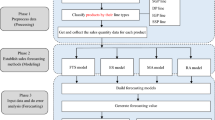Abstract
The traditional data envelopment analysis (DEA) model is widely used for efficiency evaluation of decision making unit composed of past or current input–output data in production system. We propose a new efficiency prediction model which for the first time combines information granulation (IG) and support vector machine (SVM) with DEA model, to evaluate the future efficiency of decision making unit in this paper. The model first uses fuzzy information granulation to granulate the input–output data over time series and then describe the characteristics of the data within each time window by the minimum, average and maximum values and establish the IG–SVM model based on the fuzzy information granulation and support vector machine. After training by time series data, the optimal model of regression is built. Based on this model, the minimum, average and maximum values of the next window in the future are predicted, and finally the future efficiency of the decision making unit can be calculated by the DEA model. Case studies show the feasibility and applicability of the proposed method.



Similar content being viewed by others
References
Farrell MJ (1957) The measurement of productive efficiency. J Roy Stat Soc 120(3):253–290
Li G, Shen X, Wang Y, Zhuang W (1999) DEA efficiency prediction by neural networks. Prediction 5:64–66
Wang S (2003) Adaptive non-parametric efficiency frontier analysis: a neural-network-based model. Comput Oper Res 30(2):279–295
Wu DS, Yang ZJ, Liang L (2006) Using DEA-neural network approach to evaluate branch efficiency of a large Canadian bank. Expert Syst Appl 31(1):108–115
Mostafa MM (2009) Modeling the efficiency of top Arab banks: a DEA-neural network approach. Expert Syst Appl 6(1):309–320
Tsai MC, Lin SP, Cheng CC, Lin YP (2009) The consumer loan default predicting model—an application of DEA-DA and neural network. Expert Syst Appl 36(9):11682–11690
Wu DS (2009) Supplier selection: a hybrid model using DEA, decision tree and neural network. Expert Syst Appl 36(5):9105–9112
Wang CH, Chuang CC, Tsai CC (2009) A fuzzy DEA-neural approach to measuring design service performance in PCM projects. Autom Constr 18(5):702–713
Emrouznejad A, Shale E (2009) A combined neural network and DEA for measuring efficiency of large scale datasets. Comput Ind Eng 56(1):249–254
Yulong LI, Zhongfu LI (2011) Combined DEA and neural network for predicting investment validity of infrastructure on China. Oper Res Manag Sci 20(6):88–98
Shabanpour H, Yousefi S, Saen RF (2017) Forecasting efficiency of green suppliers by dynamic data envelopment analysis and artificial neural networks. J Clean Prod 142:1098–1107
Poitier K, Cho S (2011) Estimation of true efficient frontier of organizational performance using data envelopment analysis and support vector machine learning. Int J Inf Decis Sci 3(2):148–172
Charnes A, Cooper WW, Rhodes E (1978) Measuring the efficiency of decision making units. Eur J Oper Res 2:429–444
Ebrahimi B, Tavana M, Rahmani M, Santos-Arteaga FJ (2016) Efficiency measurement in data envelopment analysis in the presence of ordinal and interval data. Neural Comput Appl. https://doi.org/10.1007/s00521-016-2826-2
Zadeh LA (1979) Fuzzy sets and information granulation. North-Holland Publishing Company, Amsterdam
Peng Y, Chen YQ (2013) Time series regression and prediction based on information granulation and SVM. Comput Syst Appl 22(5):163–206
Bargiela A, Pedrycz W (2003) Granular computing: an introduction. Kluwer Academic Publishers, Dordrecht
Vapnik VN (2000) Direct methods in statistical learning theory. Springer, New York
Vapnik VN (1995) The nature of statistical learning theory. Springer, New York
Dingcheng W, Tingjiang F, Yi T, Yongjun M (2003) Review of support vector machines regression on theory and control. Pattern Recogn Artif Intell 16(2):192–197
Chapelle O, Vapnik V, Bousquet O, Mukherjee S (2002) Choosing multiple parameters for support vector machines. Mach Learn 46(1–3):131–159
Gao Chunneng, Zhang Biao, Ji Zhicheng (2015) Study of adaptive dynamic search PSO based SVM parameter optimization. J Syst Simul 27(12):2958–2964
Zhi Su, Xiaoyuan Fu (2013) Kernel principal component genetic algorithm and improved SVR stock selection model. Stat Res 30(5):54–62
Baichuan Lu, Li Xiaolu, Guo Guilin, Huang Lili (2017) Fluctuation analysis on road traffic state based on fuzzy information granulation and support vector machine. J Chongqing Jiaotong Univ Nat Sci 36(7):83–89
Wang Xiaochuan, Shi Feng, Lei Yu, Li Yang (2013) MATLAB neural network analysis of 43 cases. BeiHang University Press, Beijing
Li Y, Zhang J, Cao Y, Zhang L (2017) Forecasting of aero-engine performance trend based on fuzzy information granulation and optimized SVM. J Aerosp Power 32(12):3022–3030
Zhang W, Gao M, Hong F, Yixin L (2018) Energy cost modeling for circulating fluidized bed boiler mix-burning coal slime based on BP-SVM and fuzzy information granulation. Proc CSEE 38(4):1093–1100
Fallahpour A, Amindoust A, Antuchevičienė J, Yazdani M (2016) Nonlinear genetic-based model for supplier selection: a comparative study. Technol Econ Dev Econ 23(1):178–195
Acknowledgements
The authors acknowledge the support of the project “the research on supply-side structural reform of manufacture enterprise under Internet + background (16BGL015)” funded by National Social science foundation of China and the project of “Research on Shaanxi Provincial science and technology innovation efficiency, mode and approach (2016D040)” funded by Shaanxi Social science foundation.
Author information
Authors and Affiliations
Corresponding author
Ethics declarations
Conflict of interest
The authors declare that they have no conflict of interest.
Additional information
Publisher's Note
Springer Nature remains neutral with regard to jurisdictional claims in published maps and institutional affiliations.
Rights and permissions
About this article
Cite this article
Zhang, Q., Wang, C. DEA efficiency prediction based on IG–SVM. Neural Comput & Applic 31, 8369–8378 (2019). https://doi.org/10.1007/s00521-018-3904-4
Received:
Accepted:
Published:
Issue Date:
DOI: https://doi.org/10.1007/s00521-018-3904-4




